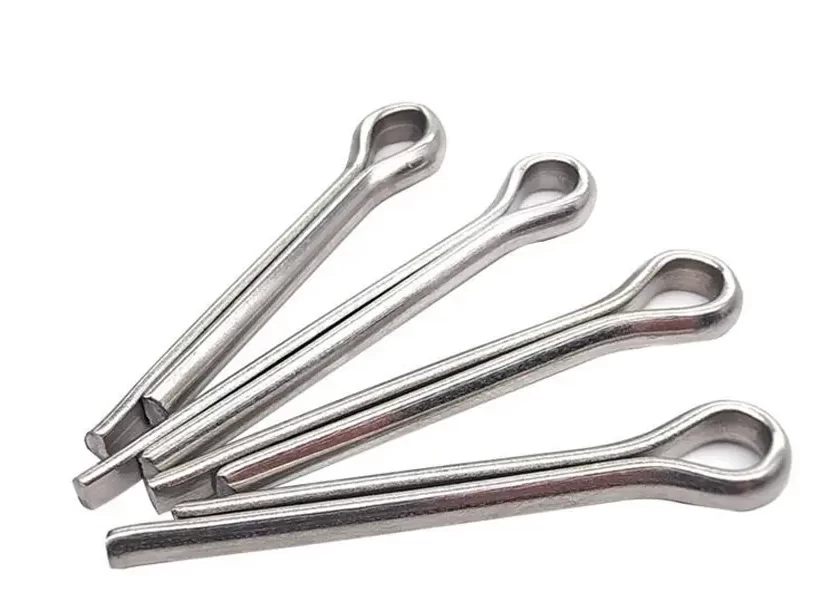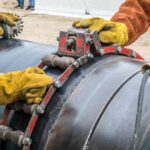A cotter pin, also known as a split pin or cotter key, is a simple yet ingenious fastening device used to secure components in mechanical systems. It is a small, U-shaped or flat piece of metal with two protruding tines or prongs at one end and a circular or elongated eye at the other.
The primary purpose of a cotter pin is to prevent the unintentional disassembly or loosening of mating parts, such as shafts, bolts, or pins, by acting as a locking mechanism. Once inserted through a hole or groove in the components being secured, the tines of the cotter pin are bent outwards, creating a physical barrier that prevents the components from separating or rotating.
Cotter pins are widely used in various industries, including automotive, aerospace, construction, and manufacturing, due to their simplicity, cost-effectiveness, and versatility. They are often employed in applications where components need to be secured temporarily or require periodic maintenance and disassembly.
Table of Contents
History and Origins
Cotter pins have been in use for centuries, with their origins dating back to ancient civilizations. The earliest known use of these simple yet ingenious fasteners can be traced back to ancient Egypt, where they were used in the construction of chariots and other wooden structures.
The name “cotter” is believed to have derived from the Old English word “codde,” which means a small piece of wood or metal used to secure something. The design of the cotter pin has remained largely unchanged over the centuries, a testament to its simplicity and effectiveness.
In the Middle Ages, cotter pins were widely used in the construction of wagons, carts, and other wheeled vehicles. Blacksmiths would forge these pins from iron, shaping them into their distinctive flat, elongated form with a split end that could be spread open to secure components together.
As industrialization took hold in the 18th and 19th centuries, cotter pins found widespread use in machinery and equipment, particularly in the growing railroad and automotive industries. Their ability to securely fasten components while allowing for easy disassembly made them an indispensable part of the industrial revolution.
Today, cotter pins remain a ubiquitous fastener in various industries, from construction and agriculture to aerospace and automotive. Their versatility, cost-effectiveness, and reliability have ensured their continued use, even in an era of advanced fastening technologies.
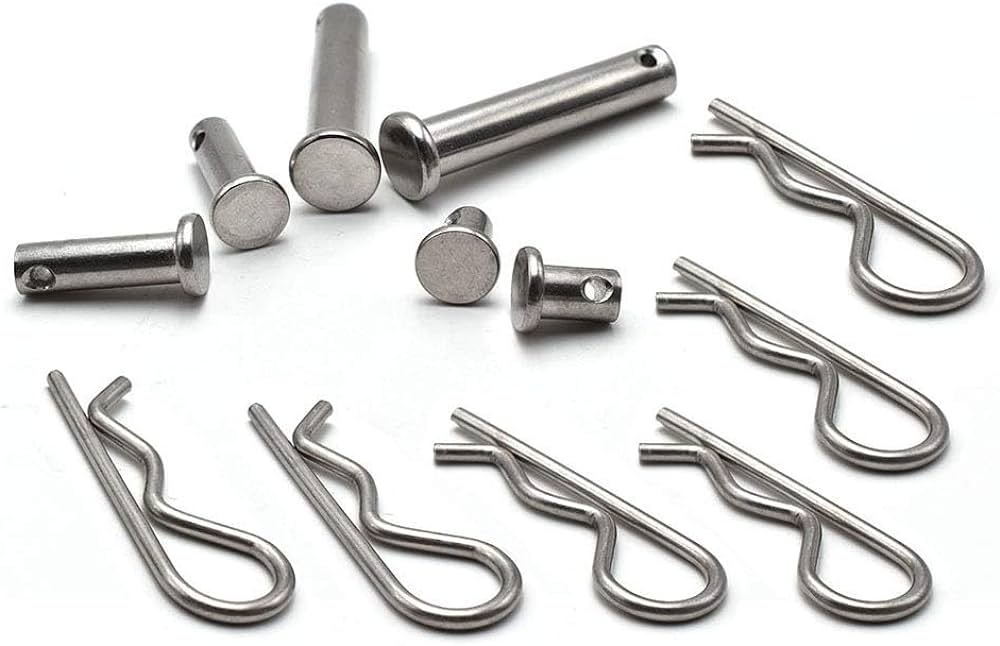
Types of Cotter Pins
Cotter pins come in various shapes, sizes, and materials to suit different applications and industries. The most common types include:
Flat Cotter Pins: These are the most widely used cotter pins, featuring a flat shape with a circular cross-section. They are available in various sizes and materials, including steel, stainless steel, and brass. Flat cotter pins are versatile and suitable for a wide range of applications.
Semi-Circular Cotter Pins: As the name suggests, these cotter pins have a semi-circular shape, resembling a letter “D.” They are often used in applications where space is limited or where a tighter fit is required.
Grooved Cotter Pins: These pins have grooves or ridges along their length, which help them grip the hole more securely. Grooved cotter pins are commonly used in heavy-duty applications or in situations where vibration is a concern.
R-Shaped Cotter Pins: These pins have a distinctive “R” shape, which allows for a more secure fit and easier installation and removal. R-shaped cotter pins are commonly used in automotive and machinery applications.
Hairpin Cotter Pins: These pins resemble a hairpin, with a bent shape and two parallel legs. Hairpin cotter pins are often used in applications where the pin needs to be easily removable, such as in agricultural equipment or machinery.
In terms of materials, cotter pins are commonly made from:
- Carbon Steel: The most common material, offering good strength and durability at a relatively low cost.
- Stainless Steel: Provides superior corrosion resistance and is often used in marine, food processing, and chemical applications.
- Brass: Offers good corrosion resistance and is often used in decorative or low-stress applications.
- Aluminum: Lightweight and corrosion-resistant, aluminum cotter pins are suitable for applications where weight is a concern.
The choice of cotter pin type and material depends on factors such as the application, load requirements, environmental conditions, and cost considerations.
Common Applications
Cotter pins are versatile fasteners found in a wide range of applications across various industries. Their simple yet effective design makes them a popular choice for securing components in machinery, vehicles, tools, and other equipment. Here are some common applications where cotter pins are frequently used:
Automotive and Transportation: Cotter pins play a crucial role in securing components in automobiles, trucks, motorcycles, and other vehicles. They are commonly used to secure castle nuts, clevis pins, and other fasteners on steering systems, suspension components, brake systems, and drivetrain assemblies.
Machinery and Equipment: In industrial machinery, cotter pins are used to secure shafts, pins, levers, and other moving parts. They can be found in manufacturing equipment, construction machinery, agricultural equipment, and many other types of heavy machinery.
Tools and Hardware: Cotter pins are widely used in hand tools, power tools, and various hardware applications. They are commonly found in pliers, wrenches, clamps, and other tools where components need to be secured or adjusted.
Outdoor and Recreation: Cotter pins are essential in outdoor equipment and recreational activities. They are used in bicycles, trailers, camping gear, and sporting equipment to secure components and ensure safe operation.
Furniture and Fixtures: In the furniture and fixture industry, cotter pins are used to secure joints, hinges, and other movable parts. They can be found in chairs, tables, cabinets, and other household or commercial fixtures.
Marine and Boating: In the marine industry, cotter pins are used to secure components on boats, ships, and other watercraft. They are commonly found in rigging, steering systems, and various marine hardware.
Overall, cotter pins are versatile fasteners that can be found in countless applications where components need to be secured or adjusted while allowing for easy removal and maintenance.
Installation Process
Installing a cotter pin correctly is crucial for ensuring the secure and reliable operation of the components it is holding together. The installation process typically involves the following steps:
- Prepare the Components: Ensure that the components to be secured by the cotter pin are properly aligned and the hole or groove for the pin is clear of any debris or obstructions.
- Select the Appropriate Cotter Pin: Choose a cotter pin with the correct size, material, and type for the application. The pin should fit snugly into the hole or groove without excessive force.
- Insert the Cotter Pin: Carefully insert the cotter pin into the hole or groove, ensuring that it passes through both components being secured. If the pin encounters resistance, do not force it, as this may damage the components or the pin itself.
- Bend the Ends: Once the cotter pin is fully inserted, use pliers or a cotter pin tool to bend the ends of the pin outward, forming a tight fit against the components. This step is essential to prevent the pin from working its way out due to vibration or other forces.
- Inspect the Installation: Visually inspect the installed cotter pin to ensure that it is properly seated and that the bent ends are securely holding the components in place.
It is essential to follow proper safety precautions during the installation process, such as wearing protective gloves and eyewear, and ensuring that the work area is clear of potential hazards. Additionally, it is crucial to use the correct tools designed specifically for working with cotter pins, as using improper tools can damage the pin or the components being secured.
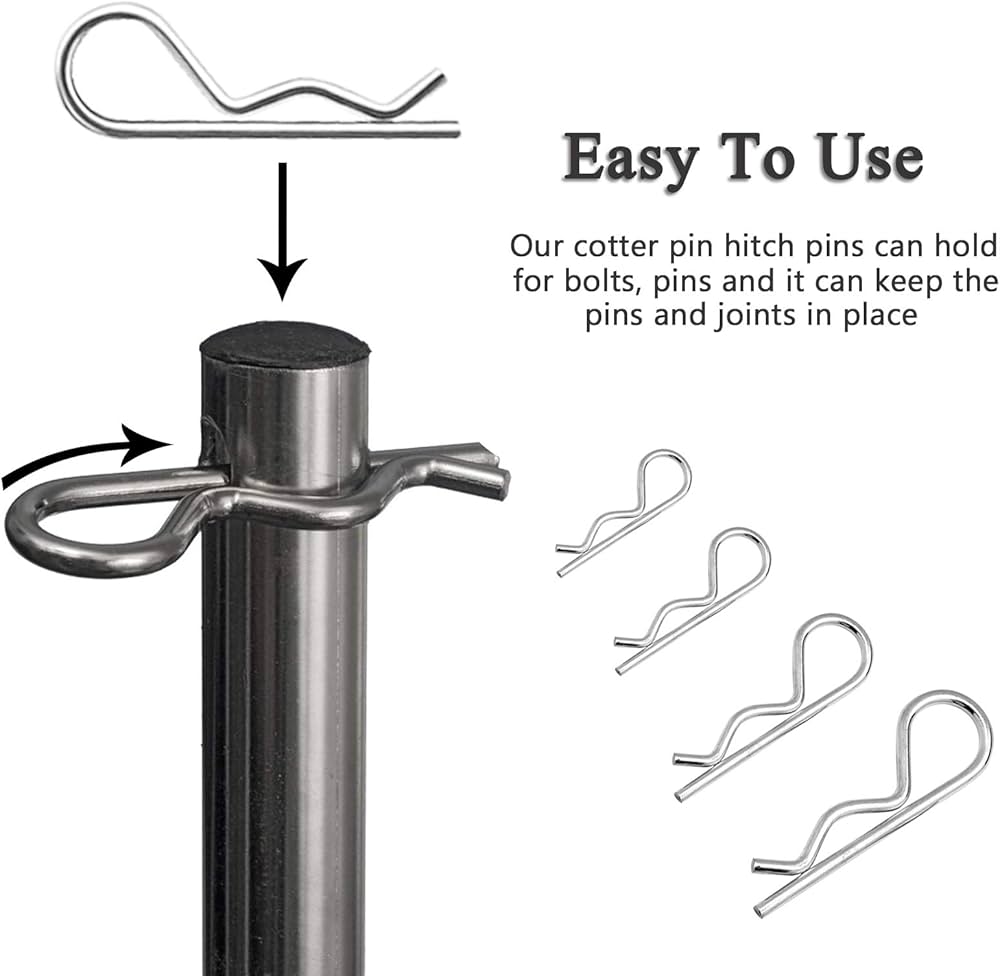
Removal and Replacement
Cotter pins are designed to be removable and replaceable, allowing for easy maintenance and repair of machinery or equipment. However, it’s crucial to determine when a cotter pin needs to be removed or replaced to ensure the safety and proper functioning of the assembly.
When to Remove/Replace Cotter Pins:
- Visible Damage: If a cotter pin appears bent, cracked, or deformed, it should be replaced immediately. Damaged cotter pins can compromise the integrity of the assembly and lead to potential failures.
- Wear and Tear: Over time, cotter pins can experience wear due to friction, corrosion, or exposure to harsh environments. If a cotter pin shows signs of excessive wear, such as thinning or loss of material, it should be replaced.
- Routine Maintenance: Many manufacturers recommend replacing cotter pins during scheduled maintenance intervals, even if they appear to be in good condition. This proactive approach helps prevent unexpected failures and ensures the reliability of the assembly.
Techniques for Removal:
- Pliers or Cotter Pin Puller: Use a pair of pliers or a specialized cotter pin puller tool to grip the exposed end of the cotter pin and pull it out. Be careful not to damage the surrounding components.
- Drift Punch: If the cotter pin is stuck or difficult to remove, you can use a drift punch to gently tap the exposed end and dislodge it from its position.
- Heat Application: In some cases, applying heat to the cotter pin can help expand the metal and facilitate easier removal. However, exercise caution and follow proper safety protocols when working with heat sources.
Inspecting for Damage:
After removing a cotter pin, it’s essential to inspect the surrounding components for any signs of damage or wear. Check the holes, grooves, or slots where the cotter pin was inserted for any deformation, burrs, or corrosion. If necessary, perform minor repairs or replace affected components to ensure a proper fit for the new cotter pin.
When replacing a cotter pin, always use a new one that meets the specified dimensions and material requirements. Reusing an old or damaged cotter pin can lead to premature failures and potential safety hazards.
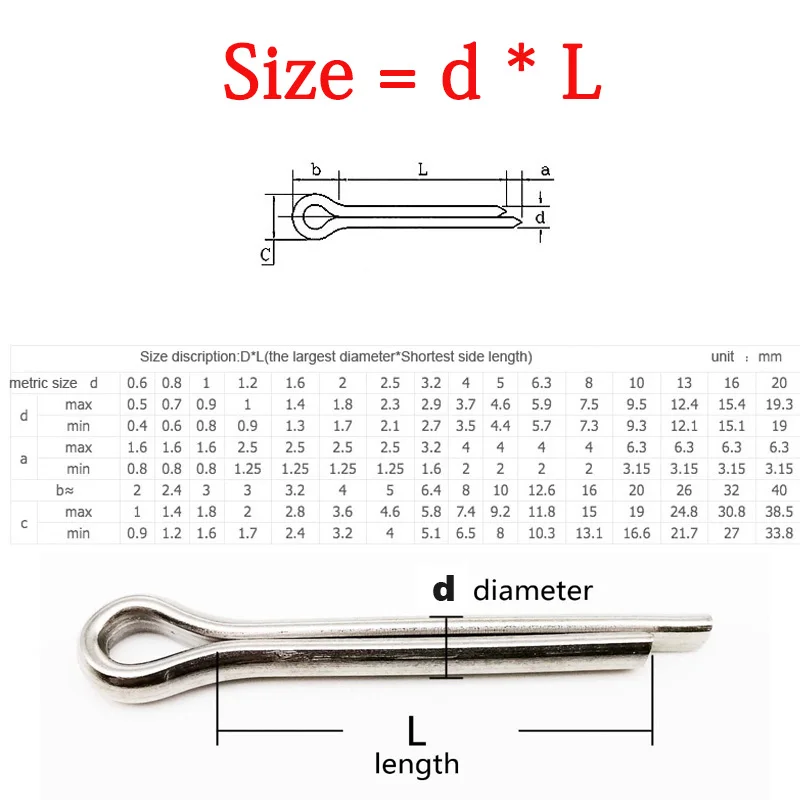
Design and Manufacturing
Cotter pins are designed and manufactured through a series of carefully controlled processes to ensure precise dimensions, strength, and reliability. The manufacturing process typically begins with the selection of high-quality materials, such as carbon steel, stainless steel, or other durable alloys, depending on the intended application and operating conditions.
The raw material is first cut or rolled into wire or rod form, with the desired diameter and length. This process can be achieved through various methods, including cold drawing, hot rolling, or extrusion, depending on the material and the required specifications.
Once the wire or rod is prepared, it undergoes a series of forming operations to create the distinctive cotter pin shape. This can involve cold heading, which uses specialized dies and punches to form the head and bend the wire or rod into the desired shape. Alternatively, some manufacturers may employ hot forging or stamping processes, particularly for larger or more complex cotter pin designs.
After the initial forming, the cotter pins may undergo additional finishing operations, such as heat treatment, to enhance their strength and durability. Heat treatment can involve processes like quenching, tempering, or annealing, depending on the material and the desired properties.
Precision grinding or machining may also be employed to ensure that the cotter pins meet the required dimensional tolerances and surface finish specifications. This step is crucial for ensuring a proper fit and smooth operation when the cotter pins are installed.
In large-scale manufacturing, these processes are often automated or semi-automated, with specialized machinery and equipment designed to produce cotter pins efficiently and consistently. Quality control measures, such as dimensional inspections and material testing, are implemented at various stages to ensure that the finished products meet the required standards and specifications.
For high-volume production, cotter pins may be manufactured using continuous processes, where the wire or rod is fed into specialized machines that perform the forming, cutting, and finishing operations in a streamlined manner. This approach allows for high production rates and consistent quality, while minimizing material waste and reducing manufacturing costs.
Overall, the design and manufacturing of cotter pins involve a combination of material selection, forming processes, finishing operations, and quality control measures, all aimed at producing reliable and high-performance components that meet the specific requirements of their intended applications.
Advantages and Disadvantages
Advantages of Cotter Pins:
- Simple and inexpensive design, making them a cost-effective fastening solution.
- Easy to install and remove, enabling quick assembly and disassembly processes.
- Versatile and can be used in various applications, from machinery to construction.
- Provide a secure locking mechanism when installed correctly.
- Available in different materials, such as steel, stainless steel, and brass, to suit various environmental conditions.
- Can be reused multiple times, reducing waste and replacement costs.
Disadvantages of Cotter Pins:
- Limited load-bearing capacity compared to other fasteners like bolts or rivets.
- Prone to loosening or dislodging if not installed properly or subjected to excessive vibration or shock.
- Can be challenging to install in tight or hard-to-reach spaces.
- Require regular inspection and maintenance to ensure proper functioning.
- May not be suitable for applications involving extreme temperatures or harsh environments.
- Can cause damage or scratches to the mating surfaces if not handled carefully during installation or removal.
When compared to other fasteners, cotter pins offer simplicity and cost-effectiveness but may have limitations in terms of load-bearing capacity and durability in certain applications. The choice between cotter pins and other fasteners depends on the specific requirements of the application, such as expected loads, environmental conditions, and ease of assembly/disassembly.
Quality Standards and Specifications
Cotter pins are relatively simple components, but they play a crucial role in ensuring the safe and reliable operation of various mechanical systems. As such, several quality standards and specifications have been established to ensure consistency, durability, and performance.
One of the most widely recognized standards for cotter pins is the American Society for Testing and Materials (ASTM) F541 specification. This standard covers the material requirements, dimensions, and tolerances for cotter pins made from carbon and alloy steel. It specifies the chemical composition, mechanical properties, and heat treatment requirements for different grades of cotter pins, ensuring their strength and durability.
Another important standard is the International Organization for Standardization (ISO) 1234 standard, which provides guidelines for the design, dimensions, and tolerances of cotter pins. This standard is widely recognized globally and ensures compatibility and interchangeability of cotter pins across different manufacturers and industries.
In addition to these general standards, specific industries or applications may have their own quality guidelines and specifications for cotter pins. For example, the aerospace industry often has stringent requirements for the materials, manufacturing processes, and inspection procedures used for cotter pins used in aircraft components.
Quality guidelines for cotter pins typically cover aspects such as:
- Material composition and mechanical properties
- Dimensional tolerances and surface finish
- Heat treatment and hardness requirements
- Corrosion resistance and plating specifications
- Inspection and testing procedures
- Traceability and documentation requirements
Manufacturers of cotter pins are expected to comply with these standards and specifications to ensure consistent quality and performance. Regular quality control checks, including visual inspections, dimensional measurements, and material testing, are typically performed to verify compliance with the relevant standards.
Safety Considerations
Cotter pins may seem small and insignificant, but they play a crucial role in securing various components, making their proper handling and installation essential for safety. Potential hazards can arise if cotter pins are not installed correctly or become dislodged during operation.
One of the primary risks is the possibility of components becoming detached or dislodged, leading to equipment failure or even projectile hazards. Loose or missing cotter pins can cause shafts, pins, or other components to separate unexpectedly, posing a risk to nearby personnel and equipment.
When handling cotter pins, it is essential to follow proper safety protocols and wear appropriate personal protective equipment (PPE). This may include safety glasses or goggles to protect the eyes from flying debris, and gloves to prevent cuts or pinches from sharp edges or springs.
During installation or removal, exercise caution when working with tensioned or spring-loaded components. Ensure that appropriate tools are used and that components are secured or released in a controlled manner to avoid sudden movements or ejections.
Regularly inspect cotter pins for signs of wear, damage, or corrosion, and replace them as necessary. Failure to do so can lead to unexpected component failures and potential safety risks.
In environments with high vibration, extreme temperatures, or corrosive conditions, it may be necessary to use specialized cotter pins or alternative fastening methods to ensure reliable and safe operation.
By adhering to proper safety procedures, using the correct tools and PPE, and maintaining regular inspections and maintenance, the risks associated with cotter pins can be effectively mitigated, ensuring a safe working environment.
Troubleshooting Common Issues
Cotter pins, despite their simple design, can sometimes cause problems if not installed or maintained properly. Here are some common issues and how to address them:
Fixing Loose Pins: If a cotter pin has become loose, it’s crucial to address the issue promptly. A loose pin can eventually fall out, potentially leading to equipment failure or safety hazards. To fix a loose pin, first try tightening it by bending the protruding ends further apart. If the pin is too loose or damaged, replace it with a new one of the correct size and material.
Replacing Damaged Pins: Over time, cotter pins can become worn, corroded, or damaged, compromising their effectiveness. If a pin appears excessively worn or deformed, it should be replaced immediately. When replacing a cotter pin, ensure that the new pin is the correct size, material, and type for the application. Refer to the manufacturer’s specifications or consult with an expert if unsure.
Preventing Future Issues: To minimize the likelihood of cotter pin problems, it’s essential to follow proper installation and maintenance procedures. Always use the correct pin size and material for the application, and ensure that the pin is securely installed with the ends properly bent and spread apart. Regularly inspect pins for signs of wear, corrosion, or damage, and replace them as needed. Additionally, consider using cotter pin pliers or specialized tools to ensure proper installation and removal, reducing the risk of damage.
Future Innovations and Alternatives
While cotter pins have been a reliable and cost-effective fastening solution for centuries, there are ongoing efforts to develop new technologies that could potentially replace or improve upon their design and functionality. One area of innovation is the development of advanced materials and coatings that offer superior corrosion resistance, strength, and durability compared to traditional cotter pins made from steel or other metals.
Another promising area of research is the use of smart materials or shape memory alloys that can change their properties or shape in response to external stimuli, such as temperature or magnetic fields. These materials could potentially enable self-locking or self-adjusting cotter pins, reducing the need for manual installation and maintenance.
Additionally, the advent of additive manufacturing techniques like 3D printing has opened up new possibilities for designing and producing customized fasteners with complex geometries or integrated features that may outperform traditional cotter pins in certain applications.
Furthermore, the integration of sensors and wireless communication technologies into fasteners could enable real-time monitoring of their condition and performance, facilitating predictive maintenance and reducing the risk of unexpected failures.
While cotter pins may continue to be used in many applications due to their simplicity and cost-effectiveness, these emerging technologies have the potential to offer improved performance, reliability, and ease of use, potentially leading to a gradual shift towards alternative fastening solutions in certain industries or applications where the benefits outweigh the costs.

